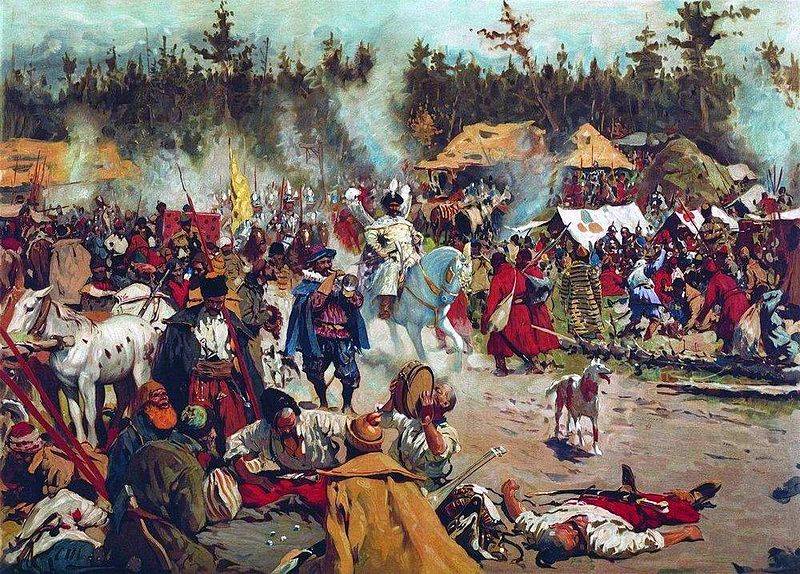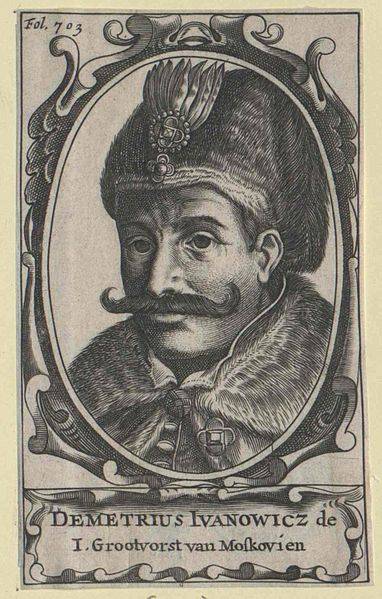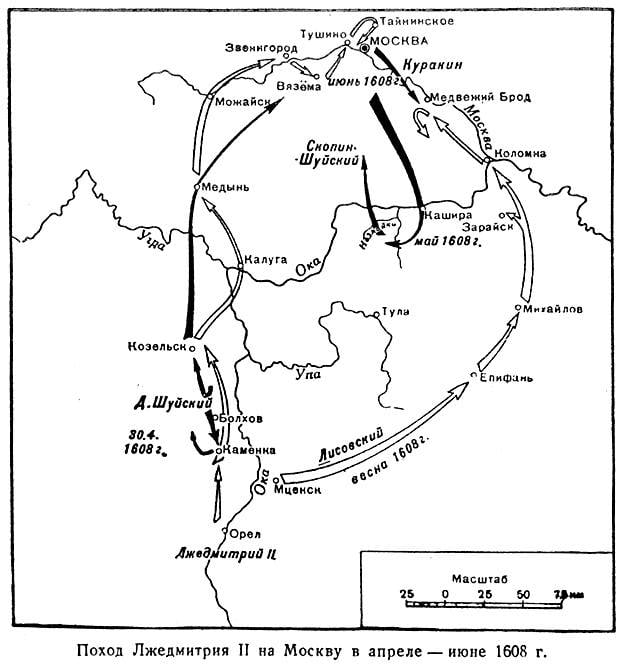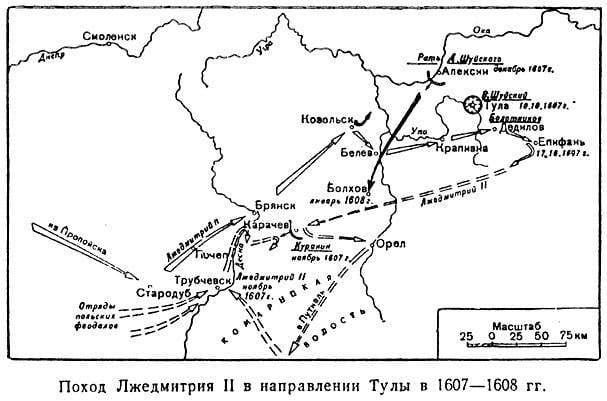"Starodubsky thief" against Shuisky. Battle of Bolkhov and Khodynka

S. Ivanov. The army of the impostor.
During the struggle between the troops of Tsar Vasily Shuisky and the Bolotnikovites, a new impostor appeared - False Dmitry II, who was a puppet of the Polish gentry. A new stage of the Troubles began, which was now accompanied by open Polish intervention. The Polish-Lithuanian gentry actively supported their protégé. The impostor's army laid siege to Moscow.
Starodub camp
While the Bolotnikovites were fighting the tsarist army, the entire Severshchina was waiting for the "exodus" of the good tsar from Poland. Putivl, Starodub and other cities have sent people abroad more than once in search of "Dmitry". A king was needed. And he appeared.
In White Russia, they found a man who looked like False Dmitry. No one knew who the new impostor was. People from the entourage of False Dmitry II considered him a "Muscovite" who lived for a long time in Lithuanian Rus. He could read and write in Russian and Polish. He knew well about the affairs of the first impostor. It is possible that he was a scribe with him and fled after the uprising in Moscow. According to the Jesuits, his name was Bogdan, and he was a Jew.
The Russian authorities eventually approved this version of the impostor's Jewish origin. The impostor's advisor, Prince Mosalsky, believed that the "thief" was the priest's son Dmitry, from Moscow. The princes of Mosalsky proved this by the fact that False Dmitry
According to another version, the impostor was a teacher from Shklov, then moved to Mogilev. There he was noticed by several gentry who served False Dmitry I. They decided that the teacher could pass for the "tsarevich". But the new "Dmitry" was a cowardly man, the fate of the impostor frightened him. He fled from Mogilev. He was found and arrested. New patrons dragged him out of prison, and the newly-made "king" became more accommodating.
The Poles decided to send the impostor to Russia not under the name of "Dmitry", but in the image of his relative Andrey Nagy. There were two people with him - Grigory Kashinets and Moscow hobbyist Alyoshka Rukin. In May 1607, "Naked" arrived in Starodub and announced that his relative "Tsar Dmitry" was alive and would soon appear.
But time passed, and the king still did not appear. From besieged Tula Bolotnikov sent ataman Ivan Zarutsky. Soon the rebels got tired of waiting, and they took Rukin to torture. He said that the "true king" already in Starodub is Nagoya. The falsehood confirmed this.
On June 12, Starodub swore allegiance to "Tsar Dmitry Ivanovich." Other southern Russian cities followed. Streltsy, Cossacks and townspeople reached out to the impostor from all sides. People also came from the Western Russian lands subject to Poland. Pan Mekhovetsky recruited several thousand people into the "tsarist" army in Belarus. He became the hetman of the "tsarist" army - the commander-in-chief. A large detachment of Zaporozhye Cossacks arrived.

To Tula
On September 10 (20), 1607, Mekhovetsky's troops marched on Tula. The cities, which the rebels approached, greeted the "king". The army of False Dmitry occupied Pochep, Bryansk and Belyov.
In October, Mekhovetsky defeated a detachment of the tsarist troops of the governor Litvinov-Mosalsky near Kozelsk. The forward detachments occupied Krapivna, Dedilov and Epifan on the outskirts of Tula, where Bolotnikov was still fighting. But the Tula garrison did not hold out until help arrived.
On October 10 (20), Tula opened the gates. Bolotnikov and "tsarevich" Peter were arrested and then executed.
Having occupied Tula, Tsar Vasily Shuisky celebrated the victory and dismissed the army, tired in a long siege, to their homes.
He overestimated his victory in Tula, underestimating his opponent. Apparently, he believed that the uprising was suppressed, the leaders of the rebels were captured, their main forces were destroyed or fled. Shuisky did not foresee timely threats from the "Starodub thief".
Meanwhile, the tsarist governors were unable to capture Kaluga, in which a large detachment of insurgents settled. Then the tsar ordered the release of the captured Cossacks taken near Moscow and Tula from the prisons, arm them and give them the opportunity to atone for their guilt with "blood". They were headed by one of the leading commanders of Bolotnikov - ataman Yuri Bezzubtsev. He had to lead the Cossacks to Kaluga and persuade its garrison to surrender.
But Tsar Vasily poorly calculated his actions. As soon as 4 thousand Cossack detachment defeated the camp near Kaluga, turmoil began in it. The royal governors could not keep the former rebels in obedience. Clashes broke out between the nobles and the Cossacks. The forces remaining loyal to the tsar abandoned their artillery and fled to Moscow.
The Cossacks gave the guns to the Kaluga garrison, while they themselves moved to join the "Dmitry".
The new impostor (unlike the first) showed himself to be a weak, cowardly person. Having received the news that Tula had fallen, he decided that everything was lost and it was time to make legs. From Bolkhov he fled to Putivl.
This led to the collapse of the original army. The Cossacks left for the cordon. False Dmitry II reached the Komaritsa region, but here he was stopped by Polish troops. Pan Tyshkevich arrived, then Pan Valyavsky, who brought 1800 infantry and cavalry to the tsarist service. The Cossacks who left were also returned.
The civil war (rokosh) ended in the Polish-Lithuanian Commonwealth. Many Polish gentry and mercenaries were left idle. Troubles in Russia attracted them with the opportunity to get a lot of good. The Russian land was considered a rich kingdom where you can make a fortune. In the army of the impostor, whole detachments were drawn by European and Polish adventurers, and then large feudal lords.
Bryansk siege. Oryol camp
Approved by strong reinforcements "Tsar" (as the Poles called him), led his troops to Bryansk for the second time. Tsarist governors rebuilt the previously burnt city.
On November 9 (19), the army of the impostor laid siege to Bryansk. The rebels besieged the city for more than a month, but could not break the courage of its defenders. The defense was led by the governors of Kashin and Rzhevsky. However, famine began in the city, there was a shortage of water, which forced the defenders to make sorties.
Regiments under the command of Litvinov-Mosalsky and Kurakin were sent to help Bryansk. Mosalsky went to the city on December 15 (25), but thin ice on the river. Desna did not allow to cross. This did not embarrass the tsarist warriors, breaking the ice, under enemy shots, they began the crossing. This determination surprised Dmitry's supporters. A fight ensued.
At this time, the garrison of the city made a strong sortie. Unable to withstand the attack from both sides, the impostor's troops retreated.
Later, Kurakin's detachment also approached. He has already delivered all the necessary supplies to Bryansk across solid ice. The rebels again tried to smash the tsarist regiments, but without success. Seeing the ineffectiveness of the siege, False Dmitry withdrew his forces to Oryol, stopping there for the winter.
During the winter, the strength of the rebel army increased significantly. The previously defeated Bolotnikovites flocked to him in groups and one by one, new detachments from Poland marched. The detachments of princes Adam Vishnevetsky, Alexander Lisovsky, Roman Rozhinsky (Ruzhinsky) arrived at the "king". Large detachments of the Don and Zaporozhye Cossacks arrived under the command of Ataman Zarutsky.
Since that time, "False Dmitry II" completely became a puppet of the Polish gentry, who determined his policy. Rozhinsky pushed aside Mekhovetsky (left with his people) and became the new hetman. Following the Polish magnates and masters, Russian boyars appeared, surrounded by False Dmitry.
The waves of turmoil again flooded the south-west of Russia. Local servants and nobles, who had previously supported the first impostor, then False Dmitry II, soon enlightened where the wind was blowing.
The "Starodubsky thief" was surrounded by Polish lords. "Thieves" ravaged lands and cities. Hundreds of noblemen from Severshchina, hiding their families, secretly fled to Moscow under the arm of Tsar Vasily.
The impostor issued a decree, according to which the lands of the "traitors" went to their slaves, they received the right to forcibly marry boyar and noble daughters or remaining landowners. Everywhere in the villages, slaves repaired violence against the remaining noblemen, beat and persecuted their clerks, shared good.
To Moscow
In the spring of 1608, the army of the impostor went to Moscow.
Lisovsky's detachment separated from the main forces at Bolkhov and moved on the eastern flank. Lisovsky captured Epifan, Mikhailov and Zaraisk. The militia of the Ryazan region under the command of Lyapunov and Khovansky opposed him. However, the tsarist governors showed carelessness and did not organize reconnaissance.
Lisovsky with a surprise attack from the Zaraisk Kremlin on March 30 (April 9) defeated the Ryazan people. Then Lisovsky captured Mikhailov and Kolomna, where an attack was not expected. Lisovsky's detachment captured the artillery park, and many former rebels joined it.
Lisovsky planned to go to Moscow, to join the main forces of False Dmitry II. In June 1608, while transporting across the Moskva River near Medvezhy ford (between Kolomna and Moscow), Lisovsky's detachment was unexpectedly attacked by the tsarist regiments under the command of Ivan Kurakin.
Burdened with artillery and carts, Lisovsky's soldiers were defeated and fled, losing all the Kolomna trophies and captives. Tsarist troops recaptured Kolomna. Lisovsky was forced to make a large roundabout march, making his way to Moscow.
To stop the troops of the "Starodub thief" Shuisky sent 30 thousand army against him under the command of his brother Dmitry. The two rats met at Bolkhov.
April 30 - May 1, 1608, the Bolkhov battle took place. First, the advance detachments of the impostor - Polish hussar companies and Cossacks - attacked the enemy. They were successfully thrown back by the noble cavalry and German mercenaries. Hetman Rozhinsky threw reinforcements into battle. And the troops of the impostor pushed the advance regiment of Golitsyn.
The situation was corrected by the Kurakin Guard Regiment. The first day ended in a draw. The next day, the Polish-Cossack troops resumed frontal attacks. They were not successful. The tsar's troops took up a strong position: the warriors were placed under the protection of a convoy, the approaches to which were covered in front by a swamp. The enemy cavalry could not use their advantages.
The defectors informed Rozhinsky about the strength of the tsarist army, the location of the regiments and their instability, and their unwillingness to fight for the Shuiskys. Rozhinsky decided to continue the battle. He moved his reserves for a flank bypass, and "reinforced" the troops at the front with a large number of transport carts carrying banners.
The appearance of a new large army at the impostor was created. Dmitry Shuisky, who was never distinguished by high fighting spirit and military talents, got scared and decided to take the artillery back to Bolkhov. This movement caused confusion in the Russian regiments. And when the Poles and Cossacks went on the offensive again, they were able to break through the line of the tsarist troops in several places.
Shuisky's army fled and was almost completely defeated. Part of the tsarist troops (5 thousand) settled in Bolkhov, but after the artillery shelling they laid down weapon and recognized False Dmitry II as the legitimate sovereign. Thousands of former tsarist warriors have joined the impostor's army.
To keep the Polish troops, which demanded money, with him, the impostor concluded a new agreement with them. He promised to share with them all the treasures that he would seize in Moscow.
Kozelsk and Kaluga surrendered without a fight. Tula also swore to the "thief". Local nobles fled to Moscow and Smolensk.
But the impostor's army was unable to go further to Moscow along the Kaluga road. There were royal regiments under the command of Skopin. The impostor and the hetman chose to abandon a new decisive battle and take a different path.
This delay obviously saved Moscow, where panic began after the defeat of the Shuiskys' army (Dmitry and Ivan).
At the same time, a conspiracy was discovered in the very host of Skopin. Several boyars (princes Ivan Katyrev, Yuri Trubetskoy and Ivan Troekurov) were preparing to support “Dmitry” and oppose Shuisky. Skopin-Shuisky had to withdraw his troops to the capital. The conspirators were arrested and sent into exile.
The rebels occupied Borisov, Mozhaisk and went to the capital city along the Tver road. In June 1608, the impostor's troops set up camp in Tushino.
Skopin stood on Khodynka opposite Tushin. Tsar Vasily with a courtyard in Presnya. The massive appearance of Poles in the impostor's army caused great alarm in the Kremlin.
The Russian government developed a vigorous activity trying to prevent a war with Poland. Shuisky hastened to complete peace negotiations with the Poles, promised to release the Mnisheks and other prisoners detained in Moscow after Otrepiev's murder home.
The Polish ambassadors, in principle, agreed to withdraw from Russia all the detachments that were in the army of the impostor. The problem was that the tycoons might not agree.
To celebrate, Vasily informed Hetman Ruzhinsky about the close peace and promised to pay the Polish soldiers the money they "deserved" in the army of the impostor. It was a mistake. For two weeks the tsarist troops were inactive, the regiments believed that the war was about to end.
The Poles used the carelessness of the Russians. On June 25, Ruzhinsky led his troops into the attack. The government forces retreated in disarray. The Tushintsy tried to break into Moscow on the retreating reaches, but were thrown back by the archers.
Ruzhinsky was already ready to retreat from Moscow. But the tsarist governors did not dare to pursue the enemy.
The Tushinites put their regiments in order and began a siege of Moscow.


Information